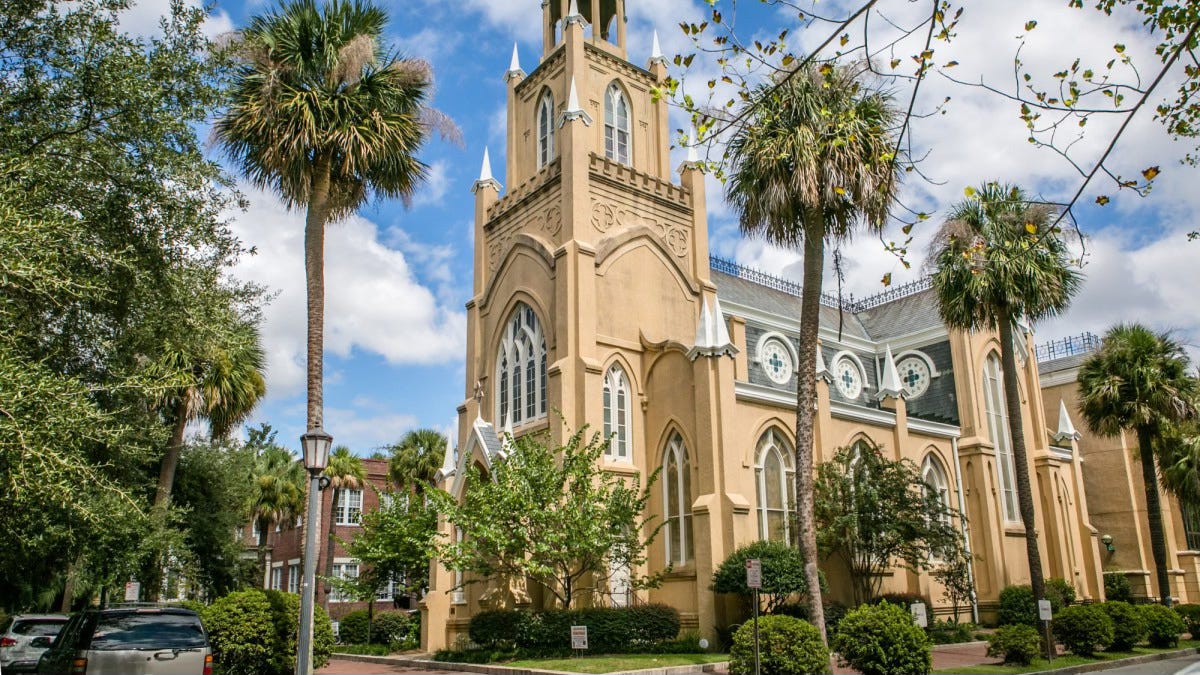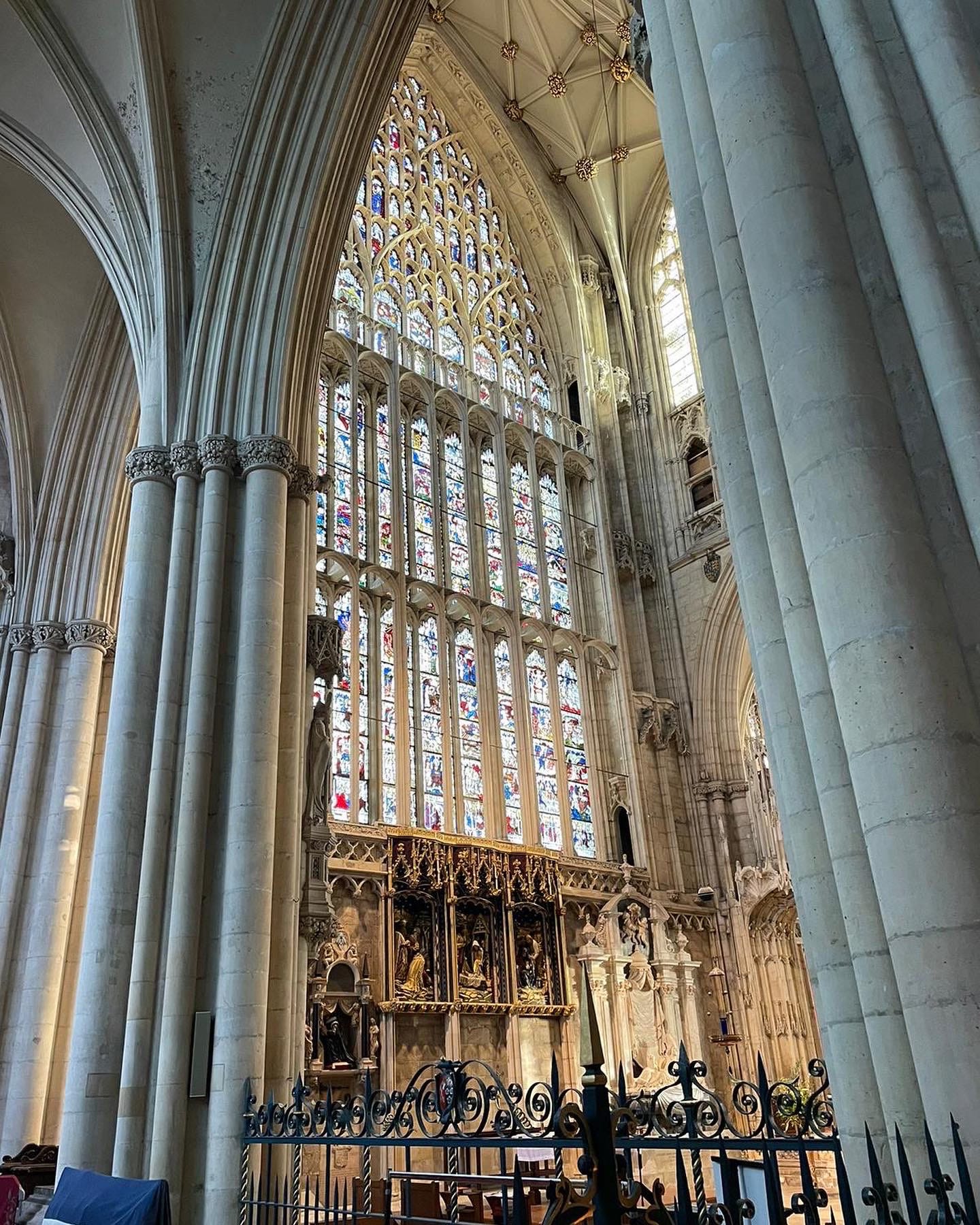A Gothic Synagogue and a Gothic Cathedral: An Essay
Gothic Architecture as an Antidote to Contemporary Narcissism
What do I love with a passion, besides reading and writing? What lifts my spirits, even after a bad day? What makes me feel that there is more to life than just mundane living…what makes me truly believe in the words of Ralph Waldo Emerson: one might think that the atmosphere was made transparent with this design, to give man, in the heavenly bodies, the perpetual presence of the sublime. For me, it is not the sky that is sublime, but Gothic architecture.
In this post, I will comment on two Gothic buildings: the Mickve Israel synagogue in Savannah, Georgia, and York Minster, a cathedral in the United Kingdom. By writing about these buildings, I hope to illustrate the importance of Gothic architecture, and how we, in our modern day and age, are in great need of it: not just aesthetically, but spiritually (no matter what our religion may be).
(source: visitsavannah).
The picture above shows the Mickve Israel Synagogue, in Savannah, United States. One may carelessly assume this to be a church because Gothic architecture is often an architectural style used for churches. However, there are synagogues designed in a Gothic style, and the Mickve Israel congregation is one of them.
It is an alluring building, because it seems to incorporate two styles. It is American, and built in the 19th century. Therefore, it can be classified as ‘Neo-Gothic’, as Neo means new, but it doesn’t matter for me. The Mickve Israel synagogue has the same sublimity and power that medieval Gothic cathedrals have- the same ability to inspire awe and reverence. Let’s dive into its history a little bit.
In the late 18th century, a little group of Jews set sail from England to live in Savannah, a border colony town known for its religious tolerance.
The synagogue throws a festival, the Shalom Y’All Food Festival, which draws 10,000 attendees annually. Furthermore, it is the third oldest synagogue in America, and named one of the fifteen most beautiful synagogues in the world.
The Allure of the Gothic
Gothic architecture has a habit of making me feel insignificant, a mere human. However, it also has the ability to make me feel as if I am part of something larger. If you’d look upon the leaping spires of the synagogue, its arched windows, you will find your gaze being drawn upwards. There is much for the eye to dwell upon, as you are being drawn into the building. Its style is quite unique: for me, it is as if someone combined traditional Gothic architecture with the soft beiges and yellows of Cotswold houses. I’ve attached a picture of a traditional Cotswold cottage to illustrate my point:
The synagogue has something sweet to it, due to its gentle beige colour and its border of palm trees. But it is not kitsch, and neither is it wholly sweet: its flying pinnacles and pointy arches install reverence into the heart of the beholder. It is welcoming, yet impressive, and it puts humans in their place. This is not a place for mortal issues: this is a house of God, and you are not in charge here. In other words, the narcissism of contemporary humanity is erased.
York Minster, United Kingdom
Let’s have a look at York Minster. The Minster is located in the North of England. I was so privileged to be able to study in York in 2023, and to visit the Minster. I also attended Sunday Services in York, despite the fact that my faith can best be described as a patchwork of ideas inspired by multiple different religions.
‘Beautiful, yet intimidating’ is how I would describe York Minster. I used to walk beneath it, gazing up at its grinning towers, the saints and gargoyles that loomed over me, the interplay of light and darkness on its creamy stone. When I looked at it, I felt as if my own humanity was gently discarded, and my soul became one with the towering walls and dizzying gables.
On a personal level, York Minster gave me spiritual strength, when I was going through one of the very few difficult moments in my exchange, after I had been manhandled by an aggressive flatmate.
(photo copyright Maryse Kluck, 2023)
It is difficult to avoid feeling empowered, or spiritually bolstered, when gazing upon York Minster, or a Gothic synagogue like the Mickve Israel synagogue. The reason, for that, I believe, is that it diminishes the egocentrism that is so prevalent in modern day culture.
William Morris and Roger Scruton: Two Different Men With Similar Ideas
William Morris was a socialist and founder of the Arts and Crafts Movement, an artistic movement that rebelled against the industrialist capitalist culture of the 19th century. Disgusted by the exploitation of the working class and the destruction of the countryside, Morris advocated for socialism and a kinder approach to nature. A multi-talented man, Morris is known to have written essays, stories, books, political pamphlets. He also produced wallpaper and infused his art with Medievalist themes.
(photo copyright Maryse Kluck 2025. Lemon Tree Bay Leaf, Melsetter Wallpapers, and Pimpernell Shamrock/Watermelon, Bedrock Park Wallpapers. Samples, mug, and coaster come from Morris & Co.)
William Morris wrote an essay on Gothic architecture, in which he described this style as carrying ‘combined strength and elegance’, one that claimed ‘homage from the intellect’. Morris even claims that ‘every part of (Gothic architecture), walls, windows, floor, was all looked upon as space for the representation of incidents of the great story of mankind’.
Morris shows us that Gothic architecture is more than a style. The architects, carvers, and designers of Gothic cathedrals and synagogues do more than just carve out a pretty building out of lifeless stone. They build something intensely powerful, one that draws in our humanity and then dissolves it, by making us part of something bigger. The power of the Gothic synagogue or cathedral lies in its beauty, and beauty, I would like to stress, is the antidote to narcissism. This brings us to Roger Scruton.
Mr Scruton would probably get into a (verbal) fist-fight with Morris if they had been introduced. Scruton was a conservative philosopher, known to aggravate liberals and progressives. One may wonder as to why I am analysing similarities between a right-leaning contemporary philosopher and a left-leaning 19th century activist, but I do believe that these two men had much in common, even if one was a die-hard conservative and the other a die-hard socialist. Their similarities? An intense appreciation, and advocation for, beauty.
Scruton complains in his book Modern Culture that in contemporary society, ‘everything is for sale’: ‘in a world in which everything is for sale, where value is price and price is value, where feelings are bartered, and the sentimental fake is no longer distinguished from the genuine article…’ In other words, there is no more beauty. There is only the kitsch and the fake, but there is not much that rouses true feelings of passion, admiration, and love. Our feelings are for sale, which may explain the rise of sensationalist contemporary literature that preys on feelings such as lust, hatred, obsession, and terror, without exploring these themes in an appropriate or philosophical manner. The rise of social media and ‘selfie’ culture has created a digital version of moral relativism, in which people can treat one another in cruel, cowardly ways (think of ghosting, online stalking, gaslighting, online bullying).
This is the problem with modern culture. I’d like to argue that, in an aesthetic way, Gothic architecture provides an antidote to these ailments. York Minster and the Mickve Israel synagogue are religious buildings, and their beauty is a medium through which the divine is represented. Scruton writes that ‘faith exalts the human heart, by removing it from the market place’.
When we look at York Minster, or the Mickve Israel synagogue, upon its ‘strength and elegance’, our hearts are exalted, and we become part of a living tradition of faith. Our hearts and minds are removed from the vulgar noise of consumer culture. Our cultural narcissism is vanquished by the majestic beauty of these buildings, as we are lost in something greater, and more eternal, than ourselves.
Reflections
Gothic architecture can serve as an antidote to the selfishness that lies at the heart of twenty-first century culture. Secularisation has, undoubtedly, brought benefits to society, but there are also disadvantages. Without God (whichever God you may believe in), we ourselves have become divinities. Enthroned by the echo-chambers we participate in, we have entered an era of self-glorification. But we can diminish this by reflecting upon Gothic architecture.
It is my hope that we can continue building in this style, as it would be better for society than the ugly, hyper-capitalistic modern buildings we have today. It gives us an opportunity to nourish ourselves with beauty and grace- and by doing so, we may as well rediscover our humanity.
SOURCES
Mickve Israel Synagogue: https://www.mickveisrael.org
More Information on the Synagogue: https://visitsavannah.com/article/visit-the-only-gothic-synagogue-north-america
‘Modern Culture’ by Roger Scruton: https://roger-scruton.com/book-shop/all-books/an-intelligent-person-s-guide-to-modern-culture-2
Morris & Co: https://www.wmorrisandco.com/uk/
‘Gothic Architecture’: Essay by William Morris







